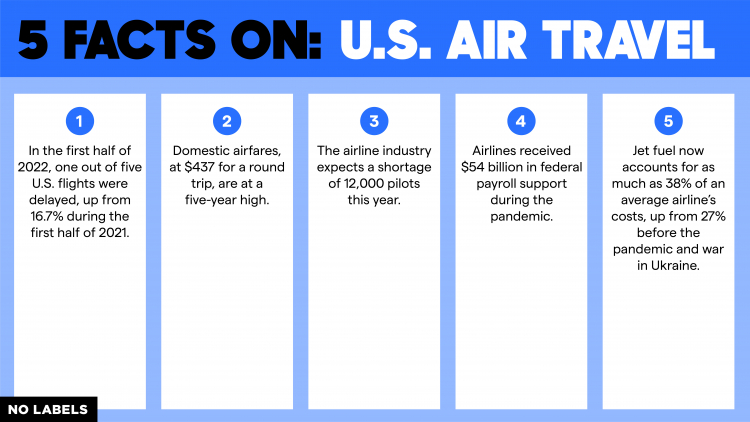Five Facts on US Air Travel

The Big Insight: Despite Congress allocating $54 billion in payroll support to save U.S. airlines in the depths of the COVID pandemic, air travel in the U.S. is a disaster — and it may not get better anytime soon due to a “perfect storm” of factors related to the pandemic and the war in Ukraine.
Americans are returning to the skies in record numbers after two years of pandemic-related wariness. But the cost of airfare is soaring, and flight delays and cancellations are on the rise. The Infrastructure Investment and Jobs Act includes historic investments in the aviation sector, but further bipartisan action may be needed to cope with the crisis.

1. In the first half of 2022, one out of five U.S. flights were delayed, up from 16.7% during the first half of 2021.
In addition, 2.8% of all U.S. flights were cancelled, up from 2.1% last year. Nearly 2.5 million Americans flew on the Friday before Independence Day, the highest single day for air travel since before the pandemic. That day, 27% of U.S. flights’ arrivals were delayed, with an average arrival delay of 51 minutes.
There are many reasons for delays. About 70% of delays are weather-related, but this year has also seen delays due to increased demand and a pilot shortage.
2. Domestic airfares, at $437 for a round trip, are at a five-year high.
That average is up 45% compared with 2019. Travelers planning to leave the country can expect to pay closer to $1,200 per round trip ticket, up 31% compared with 2019. Delta CEO Ed Bastian predicts that fares this summer may be 30% higher on average than before the pandemic.
In the first quarter of this year, U.S. passengers spent $21 billion on domestic flights — compared to $56 billion spent in the entirety of 2021.
3. The airline industry expects a shortage of 12,000 pilots this year.
According to the Air Line Pilots Association, just 8,000 new pilots have been certified in the past year. Several factors are causing the pilot shortage. Federal regulations require pilots to retire at age 65, and about 5,800 pilots reach that age each year. Sen. Lindsey Graham (R-SC) and some others have proposed lifting the mandatory retirement age to 67 or higher. (The mandatory retirement age was 60 until 2007.)
4. Airlines received $54 billion in federal payroll support during the pandemic.
While those dollars were intended to let airlines retain pilots and other employees so they would be ready to work when demand returned, airlines instead provided workers with early retirement packages and incentives to leave. Overall airline industry employment fell by 50,000 during the pandemic, including more than 6,000 pilots.
5. Jet fuel now accounts for as much as 38% of an average airline’s costs, up from 27% before the pandemic and war in Ukraine.
At the beginning of this month, jet fuel cost airlines $3.90 per gallon. While that is less than motorists are paying for gasoline, it is more than twice the $1.89 per gallon airlines were paying one year ago, and more than six times the pandemic low. Airlines are passing on the cost to passengers.
No Labels is an organization of Democrats, Republicans, and independents working to bring American leaders together to solve problems.





